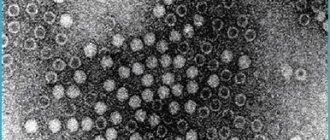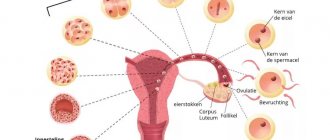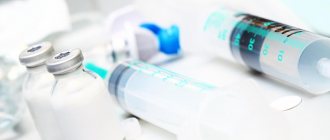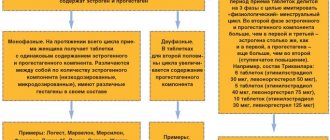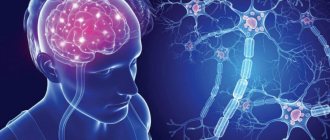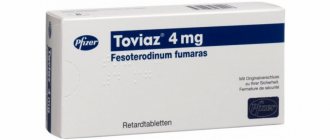August 24, 2021
Spinal muscular atrophy
SMA (spinal muscular atrophy) is a group of genetic diseases that involve the loss or death of motor neurons in the spinal cord. A characteristic symptom is disruption of the striated muscles of the legs, head and neck. The arm muscles are not affected, sensitivity is preserved, and intellectual development is not impaired.
There is no proven effective treatment. The patient is prescribed supportive therapy and special nutrition. Potaba against muscle atrophy is indicated as an additional source of vitamin B.
Cause of SMA
SMA is a hereditary disease and is associated with mutations in the SMN1 gene.
For the disease to manifest itself, both parents must be carriers of a mutation in this gene. Approximately every 40th person has the recessive SMA gene. The probability of having a sick child from two carriers is 25%; with the same probability, a child of two carriers will not have a gene defect. In another 50% of cases, he will be a carrier of SMA, but will not get sick himself.
In rare cases (less than 2%), affected children are born into families where only one parent is a carrier. In the second parent, a gene mutation occurs when an egg or sperm is laid.
If your child has been diagnosed with SMA, I want to talk to you
What is damaged as a result of mutation?
Due to a defective gene in the body, the production of the SMN protein, the survival protein of motor neurons, is disrupted. Without this protein, motor neurons - the nerve cells of the spinal cord responsible for coordination of movements and muscle tone - die, the signal does not go to the muscles of the legs, back and partly the arms.
Without the necessary tone, the muscles gradually atrophy. The absence of abdominal and back muscles leads, among other things, to extensive curvatures of the spine, and these lead to breathing problems, which already exist due to weak muscles.
The disease can manifest itself from the first months of life or at a later age.
Image from bfm.my
What determines the severity of the disease?
Two genes are responsible for the production of the SMN protein – SMN1 and SMN2.
At the same time, SMN1 is the main “customer” of this protein, and SMN2 is an additional one; it produces protein in an amount insufficient for the normal functioning of the body. In cases where SNM1 is absent from the human genome, SNM2 begins to perform replacement functions, but can never completely compensate for the deficiency.
There are up to eight copies of SMN2 in the genome. The severity of the patient’s condition depends on the number of SMN2 copies a person has. Such a complex mechanism of the disease leads to the fact that SMA has several forms, and the condition of patients is very different.
Competition "bio/mol/text"-2018
This work was published in the “Biopharmaceutics” category of the “bio/mol/text” competition 2018.
The nomination partner is medical.
The general sponsor of the competition is: the largest supplier of equipment, reagents and consumables for biological research and production.
The audience award was sponsored by the medical genetics center Genotek.
"Book" sponsor of the competition - "Alpina Non-Fiction"
Figure 1. Internal structure of the spinal cord. 1 - posterior horns of the spinal cord; 2 - lateral horns; 3 - front horns; 4 - central channel; 5 - central intermediate substance; 6 - posterior central groove; 7 - posterior lateral groove; 8 - anterior central slot; 9 - posterior cords; 10 - lateral cord; 11 - anterior cord.
[1]
Today, science knows a huge number of genetic diseases, the treatment of which poses a serious problem. One of them is SMA . Spinal muscular atrophy is an orphan, that is, rare, genetic disease. It is characterized by gradual degeneration of α-motor neurons in the anterior horns of the spinal cord. The anatomical location of the anterior horns of the spinal cord is presented in Figure 1 [1].
Alpha motor neurons innervate extrafusal muscle fibers, which are responsible for contraction of skeletal muscles. The relationship between neurons and muscle fibers is shown schematically in Figure 2.
Figure 2. Interaction between motor neurons and muscles. 1 - large alpha neuron; 2 - gamma neuron; 3 - small alpha neuron; 4 - muscle; 5 - proprioceptor; 6 - corticospinal tract; 7 - reticular-spinal tract; 8 - descending pathways of the extrapyramidal system; 9 - spinal node.
[2]
As can be seen from the figure, to maintain muscle tone and contraction, the coordinated work of many components of the neural network and muscle fibers is necessary [2]. In SMA, one of these components ceases to perform its function, which ultimately leads to muscle atrophy.
As a rule, SMA is associated with losses of a chromosome region or point mutations of the SMN1 gene (survival motor neuron, or motor neuron survival gene) [3]. Although there are even rarer forms of spinal muscular atrophy that are not associated with SMN1 mutations, this article will only talk about “classic” SMA, or 5qSMA - this name is due to the fact that the mutation affects chromosome 5 specifically.
Figure 3. Inheritance of SMA
[4]
The incidence of this pathology is one case per 6–10 thousand people. Moreover, every 40–50th inhabitant of the Earth is a carrier of the “broken” SMN1 gene. If two people, each of whom is a carrier of a mutated gene, become parents, then the probability that their child will have SMA is 25% (Fig. 3) [4].
What is the SMN gene responsible for if its mutations lead to such consequences?
In humans, there are two SMN genes: SMN1 and SMN2, which are located on chromosome 5. The mutation usually affects the SMN1 gene. As a result, the synthesis of the SMN protein is disrupted. As a result, all functions for the synthesis of SMN are taken over by the SMN2 gene. However, between the SMN1 and SMN2 genes there is a seemingly tiny difference of one nucleotide at the beginning of exon 7, but it is this nucleotide that affects the process of splicing - the removal of non-coding sequences from preRNA. The SMN2 gene, due to its structure, cannot ensure the synthesis of a sufficient amount of stable and functional SMN protein (Fig. 4) [4].
Figure 4. Schematic representation of the segment of chromosome 5, which contains the SMN1 and SMN2 genes. The diagram shows that exon 7 of the first gene under consideration contains the nucleotide cytosine, and the second contains the nucleotide thymine. Because of these differences, the SMN2 gene cannot synthesize a functioning full-length protein in the required quantities.
[4]
SMN is essential for the functioning of all cells in the body [4]. Why then is it that motor neurons are so sensitive to its lack? Researchers from Emory University provide the following explanation for this phenomenon. The fact is that in every cell, mRNA is read from DNA and, subsequently, serves as the basis for protein synthesis. However, in order for the synthesis of a protein molecule to begin, the mRNA must be delivered to a specific point in the cell. Each messenger RNA has a region that codes for the site of delivery. The SMN protein is responsible for the correct reading of this information, and if it is missing, this mechanism is disrupted.
Since spinal motor neurons have very long axons, disruption of mRNA transport becomes critical for them. Due to the fact that the mRNA does not reach the ends of the axons, neuronal death occurs, and, as a consequence, subsequent muscle atrophy [5–7].
However, the role of the SMN protein in neurons is not limited to just a transport function. Figure 5 displays the main functions of SMN in neurons [8].
Figure 5. Functions of the SMN protein in a neuron
[8]
What forms of SMA exist?
There are 4 types of SMA, differing in severity and age at which the disease first appears.
SMA I, Werdnig-Hoffman disease. The most severe form of the disease manifests itself in infants from 0 to 6 months. Children with this form from birth have difficulties with breathing, sucking and swallowing, and also do not master the simplest controlled movements - do not hold their head up, do not sit independently. Previously, it was believed that the majority (80%) did not live beyond two years of age. Now, thanks to new strategies for mechanical ventilation and tube feeding, life can be extended by several more months.
SMA II, Dubowitz disease. The first manifestations of the disease are at 7-18 months. A person with this type of SMA can eat and sit, but cannot walk independently. Life expectancy depends on the degree of damage to the muscles that provide breathing.
SMA III , Kugelberg-Welander disease. The disease first appears after one and a half years. Such patients can stand (in pain), but do not walk. SMA type III, as a rule, does not affect life expectancy, but it greatly worsens its quality.
SMA IV , this type is also called “adult SMA”, since the disease usually manifests itself after the age of 35. Symptoms include muscle weakness, scoliosis and tremors. In addition, joint contractures (limited joint mobility) and metabolic disorders develop. The progression of the disease is not very rapid, first muscle weakness affects the muscles of the legs, then the arms. Typically, patients do not have problems with swallowing and respiratory function. Most patients with type IV SMA can walk, and only a few have to resort to wheelchairs.
SMA associated with a violation of the SMN gene is called proximal in the medical literature - they make up 95% of all spinal amyotrophies. There are quite a lot of SMAs not associated with the SMN gene, but they are rare. These include, for example, Kennedy's disease. Studies in the 1990s showed that Kennedy's disease is not associated with a breakdown of the SMN1 gene, but with other genetic mutations that lead to impaired absorption of the SMN protein. The disease manifests itself in people over 35 years of age. SMBA is characterized mainly by weakness of the limbs.
One type of SMA that is not associated with the SMN gene is called Kennedy disease. The fact that this disease is still sometimes referred to as SMA is an anachronism. In the late 1960s, when this atrophy was described in detail, it was considered a type of SMA because it affects the same nerves and muscles as the three types of SMA (but to a much lesser extent).
Genetic editing: will SMILES wait?
The action of all the drugs described above is based on working with the SMN2 gene. However, the main problem for people suffering from SMA is the lack of full functioning of the SMN1 gene, since SMN2 cannot completely replace it. So is it possible to approach the problem from this side? It turns out that it is possible! This is where genetic editing technologies come to the rescue.
For several years now, the scientific community has been actively discussing the use of CRISPR/Cas9 technology to solve a number of global problems facing humanity, as well as the ethical issues associated with it. The technology makes it possible to edit the genomes of all living organisms, including humans. You can read more about this in the articles “Mutagenic chain reaction: genome editing on the verge of science fiction” [25] and “Shouldn’t we take a swing at... changing the genome” [26].
Today, active research is underway to develop CRISPR/Cas9 methods for the treatment of HIV, cancer, Duchenne myopathy, and now the turn has come to SMA [27].
Figure 10. Logo of AveXis, the first developer of gene therapy for SMA patients
[28]
AVXS-101 is a drug developed by AveXis (Fig. 10) [28].
Unlike the drugs described above, AVXS-101 does not affect the functioning of the SMN2 gene; its target is SMN1. As a result of the use of gene therapy, a mutated or missing gene is replaced by a functionally complete one, capable of synthesizing a full-length, stable SMN protein. This is difficult to imagine, but technically it is quite possible to implement [29]. Moreover, AVXS-101 has already passed the animal study stage and is now in clinical trials in humans.
Today, two possible ways of administering the drug are being considered: intravenously and directly into the cerebrospinal fluid. The second option, although technically more complex, can reduce the need for medication for adult patients, especially those who are overweight. This route of administration makes AVXS-101 available to more people.
In October 2021, AveXis made an announcement that brought another ray of hope to all SMILES: AVXS-101 was submitted for approval to the medical registration authorities of the United States, Europe and Japan. If no unforeseen circumstances arise, the first drug for genetic therapy for SMA will be registered in mid-2021.
After registration, it is planned to be used to treat infants with SMA I up to 9 months of age. However, over time, AVXS-101 will be used in other patient groups [25].
Of course, despite all the promise of this drug, it is necessary to remember that this technology is still very new, which means that various unexpected side effects are possible in the long term.
To summarize, SMA is still a serious disease that significantly reduces the quality of life of patients and their families and often leads to death in childhood or adolescence. But the dynamics of the development of new drugs allows us to hope that the situation will soon change for the better. I would like to see treatment become more effective and accessible in the coming years for citizens of different countries, and not just residents of the European Union and the United States. And we will wait for AVXS-101 to enter the pharmaceutical market, since this drug promises to become a new turning point in the treatment of the disease under discussion. The main thing is that as many SMILES as possible can wait for this day, since for many of them even six months is a very significant period.
How is it treated?
Image from the site asesoramientopsicologicoalicante.es
In recent years, anti-SMA drugs have been actively being developed in the world, three of them are already used in the world, the rest are at different stages of development.
Spinraza, a drug developed by Biogen, increases the production of the SMN protein from the “reserve” SMN2 gene. With regular therapy, Spinraza stops the development of SMA and stabilizes the patient's condition.
Spinraza is available in a dosage of 12 mg per 5 ml for intrathecal administration (directly into the cerebrospinal fluid) and is approved for all ages and types of SMA without any restrictions.
In the first year, you will need to make 6 injections: 3 doses at a 14-day interval, 1 dose after 30 days and then once every 4 months. Subsequently, the drug will need to be used continuously throughout life every 4 months.
The drug should be started as soon as the diagnosis has been made. The effectiveness and safety of nusinersen has been studied in children aged 0 to 17 years; experience in patients over 18 years of age is limited; the use of the drug in patients over 65 years of age has not been studied.
After using Spinraza, improvements in motor activity were observed in patients with SMA types I, II and III. Possible complications of Spinraza include upper respiratory tract infection, lower respiratory tract infection and constipation, and may also develop atelectasis, coagulation abnormalities and thrombocytopenia, including acute severe thrombocytopenia, as well as the development of glomerulonephritis.
On February 13, 2021, Spinraza received orphan status in Russia. On August 16, 2021, the drug was officially registered in Russia.
On August 3, 2021, the Ministry of Health commission recommended that the government include a drug for the treatment of spinal muscular atrophy in the list of vital and essential drugs for the next year. However, as of September, negotiations on reimbursement from the federal budget for 2021 have not been completed.
There are precedents for successful cases where the court ordered regional authorities to provide patients with Spinraza at the expense of regional budgets.
The cost of the drug is about 8 million rubles per injection.
Zolgensma is the first gene therapy drug developed to treat spinal muscular atrophy (SMA). Designed to address the genetic cause of SMA by replacing the defective or missing SMN1 gene to stop disease progression. The drug delivers a fully functional copy of the SMN gene into the human body. The drug was developed by Avexis for single use (one injection for life).
The drug is currently approved in the United States for patients with SMA under 2 years of age, including those who are asymptomatic at diagnosis. In Europe, the drug is received by patients with SMA type I with a copy number of SMN2 of no more than 3 copies, a weight limit of 21 kg. The drug is administered intravenously once, the dose is determined taking into account the child’s body weight.
The most effective use of the drug is before the first symptoms of the disease appear in children whose presence of SMA is determined by screening results. Research on the use of the drug in older children who already have symptoms of SMA is ongoing.
The most common adverse reactions associated with the use of Zolgensma were increased activity of liver enzymes and vomiting. The instructions for use of the drug contain a warning about the risk of developing severe acute liver damage.
In mid-July 2021, I submitted a dossier to the Ministry of Health of the Russian Federation to register the drug for use in Russia. According to the current procedure, the registration process can take up to six months.
Currently, the manufacturing company has announced a compassionate use program (prior to the official registration of the drug), under which 100 doses of the drug will be distributed among one hundred patients with SMA of any type for up to two years using a lottery method. In Russia, 4 children received the drug under this program.
In addition, 16 Russian children received the drug at the expense of philanthropists, and two more are taking part in the clinical trial program.
The cost of a dose of the drug is about 152 million rubles (the most expensive drug in the world).
Risdiplam (RG7916) (“Evrisdi”), a drug from Roche, is a splicing modifier (genetic modification) of the SMN2 gene, increasing the expression of full-length functional proteins. Unlike other drugs, it is administered orally.
The studies were conducted on patients from 0 to 60 years old with SMA types II and III. Improves motor function of patients. No contraindications have been registered to date.
On March 18, 2021, I submitted an application for consideration for further registration of the drug to the Ministry of Health of the Russian Federation.
Currently, the manufacturer has opened a program for pre-registration access to the drug.
In addition, clinical trials of several more drugs are underway around the world - branaplam, reldesemtiv, SRK-015 and others.
According to doctors, a combination of drugs in the treatment of SMA is possible, but its feasibility should be considered in each case individually.
Treatment of muscle atrophy
There is currently no effective treatment for muscle wasting. The patient requires supportive care. Otherwise, his condition deteriorates sharply.
Improvement in the condition of patients with SMA is only possible with an increase in the production of the SMN protein. The main results have been obtained, but the drugs are at the stage of clinical trials.
Approved drugs:
- Spinraza, USA - an oligonucleotide that promotes the formation of the SMN protein. Injected endolumbarally;
- Zolgensma - for children under 2 years of age - provides replacement for the missing or defective SMN1 gene. The patient's DNA remains unchanged. It can be used both in patients with symptoms and in patients without signs of the disease, but with identified genetic abnormalities. The course is 1 dose, but the cost of the drug is $2 million.
Treatment methods currently used depend on the type of SMA and the severity of the disease. The patient should be under the supervision of a therapist, pulmonologist, neurologist, orthopedist, geneticist, gastroenterologist and rehabilitation specialist.
The main problems that the doctor and the patient’s relatives have to solve:
- insufficient coughing, discharge of mucus from the lungs;
- underdevelopment of the lungs, insufficient ventilation during sleep;
- reduced immunity, infections that increase the rate of muscle atrophy;
- violation of swallowing processes.
Respiratory system diseases are the main cause of death in patients with SMA. Therefore, it is necessary to ensure high-quality ventilation of the lungs during respiratory diseases and during daily care.
Monitoring of the condition of the respiratory system is carried out every 4–6 months. The task for doctors and relatives is to try not to end up in intensive care units, not to use non-invasive methods of ventilation, and to avoid tracheotomies.
For all patients, antibiotics are prescribed according to indications, drugs that relieve gastroesophageal reflux, and dietary nutrition. In addition, it is necessary to exclude growth disturbances, underweight and excess weight.
Orthopedic support is indicated to prevent the development of contractures, spinal deformities, pain, and fractures. Neurosurgical interventions are performed according to indications, and the use of prostheses and orthoses is prescribed. Walking should be encouraged like any other physical activity. This improves the patient's condition and keeps muscles toned.
Drug therapy includes:
- preparations based on L-carnitine and coenzyme Q10;
- nootropics to improve tissue trophism;
- B vitamins - for example, Potaba. They increase oxygen levels in tissues. Previously, such drugs were administered by injection; Potab capsules for oral administration facilitate the care of patients with SMA;
- vitamin E;
- valproates, although their effectiveness has not been proven;
- salbutamol to improve sputum discharge;
- gastrointestinal motility regulators;
- antacids.
Is it possible to help patients with SMA and how exactly?
It is not yet possible to cure the disease, but it is possible to alleviate the condition of patients with SMA, that is, in various ways to compensate for the manifestations of the disease.
In severe types of SMA, patients must be helped to breathe and swallow. Therefore, they vitally need mobile ventilators, cough aspirators, and Ambu bags.
Children with SMA also really need the help of volunteers who can replace their parents at least for a short time.
Children with SMA may need help at any time, so moms and dads are always on the alert and themselves master the resuscitation skills necessary in case the child suddenly stops breathing.
Less severely ill patients need medications to make breathing easier, corsets, strollers and other devices that make it easier for people with weak muscles to move and live.
An illness that lasts for many years is exhausting, so patients, especially adults, often need the help of a psychologist.
Photo from the site f-sma.ru
The SMA Families Charitable Foundation helps children and adults with spinal muscular atrophy and other neuromuscular diseases and their families.
The fund operates throughout Russia. The work of the foundation has two main directions - providing assistance to SMA patients themselves and their loved ones and working for systemic changes in the situation with SMA in Russia.
You can support the foundation's activities by making a donation in any way convenient for you. You can help by making a one-time or regular donation on a special page of the fund or by sending an SMS to the short number 3443 with the word SMA and, separated by a space, the donation amount - for example, SMA 300.
Olga Germanenko: “I perceive my daughter’s illness as a reward”
Is Nusinersen an Effective Treatment or a False Hope?
For a long time, genetic diseases were considered incurable by default. But today people have set their sights on treating these pathologies. It cannot be said that this always turns out successfully, but new attempts are made with enviable regularity.
So, after the genetic nature of SMA was clarified, the search began for drugs that could at least partially correct the genetic defect. And so, on December 23, 2021, SMIles and their families were excited by the sensational news: the FDA (American Food and Drug Administration) registered the first medicine against SMA - nusinersen (commercial name Spinraza, manufacturer - Biogen) (Fig. 9). A few months later, the drug was approved by the EMA, the European Medicines Agency [17].
Figure 9. The first registered drug for the treatment of SMA - nusinersen (Spinraza)
[17]
How does nusinersen work? It corrects defects in messenger RNA splicing of the SMN2 gene, which in turn increases the production of SMN protein. Unfortunately, Biogen representatives have not yet disclosed the mechanism of action of this drug in more detail. Therapy is carried out in a hospital with the participation of a multidisciplinary medical team, which should consist of a pulmonologist, a physiotherapist and a resuscitator. The medicine is injected directly into the cerebrospinal fluid. Every SMA patient needs several injections of nusinersen per year. The main side effects of the drug include upper and lower respiratory tract infections and constipation.
Before registration, clinical trials were conducted on a group of 121 patients with infantile onset of the disease. Some patients received the drug, and some received a placebo. The study found that 51% of patients responded to nusinersen treatment compared to the control group. These children had improved motor skills and a reduced risk of death and permanent ventilation. However, this study also means that, unfortunately, 49% of patients who received nusinersen in the study did not experience improvement in motor skills.
Subsequently, the manufacturing company conducted studies of the drug in people with later onset of SMA. Observations were conducted on patients for 15 months. As a result, it was noted that on the Hammersmith scale, which allows you to assess the level of motor skills of SMIlies, patients receiving the drug improved their performance by 4 points on average, while in SMIlies from the control group the indicators worsened by 1.9 points [18 ].
Today, as Biogen representatives say, the use of nusinersen is recommended for patients of any age and for any type of SMA.
In October 2021, she presented new data on the drug nusinersen at the annual Congress of the World Society of Neuromuscular Diseases. This time, the studies were conducted on presymptomatic infants with SMA. Representatives of Biogen claim that impressive results were obtained: after using nusinersen, 100% of subjects were able to sit without support and 88% were able to walk [19]. The results are encouraging, but newborn screening aimed at early detection of SMA is necessary to apply treatment to presymptomatic infants. Such studies have not yet been carried out in Russia and other post-Soviet states and, knowing the inertia of domestic healthcare, we can assume that they will not be carried out soon.
The news about the appearance of the first registered drug for the treatment of SMA seemed fantastic. A disease that is very often fatal can now be treated! SMILES have a chance to live!
However, the delight of patients and their families diminished significantly when the drug manufacturer announced the price. A person suffering from SMA needs several injections per year and their total cost is several hundred thousand dollars. This amount is unaffordable for most SMA families. However, in the USA and the European Union, you can use insurance for treatment. Therefore, the use of the first drug against SMA has already begun to gain momentum.
However, outside the United States and the European Union, the drug in question was not greeted with great enthusiasm everywhere. Thus, in the UK, nusinersen faced a number of difficulties. NICE - the National Institute for Health and Care Excellence - has not approved the use of nusinersen for the treatment of spinal muscular atrophy. At the same time, NICE representatives talk about the possible “significant benefit” of the use of this drug for SMA patients, but also note that due to “significant uncertainty, especially regarding the long-term prospects” and the high cost of the drug, they cannot recommend it for therapy for spinal muscular atrophy. At the same time, the organization states that it is ready for “further discussion” of the current situation with representatives [20], [21].
This drug is also still not registered in Russia and other post-Soviet countries. This means that even if the patient’s relatives somehow miraculously obtain this medicine, not a single Russian doctor has the right to use it, so treatment is currently only possible abroad.
Patients and their families are concerned with the following question: is nusinersen really a panacea for SMIles? Unfortunately, there is no clear answer to this question. Some doctors strongly believe that nusinersen is a breakthrough in the treatment of SMA. So, for example, Eduardo Tiziano, one of the leading experts in the diagnosis and treatment of SMA, not so long ago, during his visit to Russia, said that “SMA is no longer incurable” and that “several methods of treating SMA will appear in the near future "[22]. Other doctors recall the results of clinical studies, and that in 49% of patients in the infantile group, in whom treatment began after the onset of symptoms, the drug did not give any positive result [18]. In addition, it is unknown how long-term the effect of nusenersen is [17].
The families of SMAiliks, for the most part, are of the opinion that this drug, at a minimum, will allow their loved ones to stay alive and wait for a fundamentally different means of treating SMA. Which one? Read below. But first, about drugs created to combat SMA, which are similar in their action to nusinersen.
Is it possible to get SMA due to vaccinations?
In Europe and the USA, the connection between vaccinations and the manifestation of the disease has not been traced.
Understanding whether there is a connection between SMA and vaccines may help explain the difference between SMA and polio. Poliomyelitis is an infectious disease when the infection damages the body of an initially healthy child. A child with SMA, born with a damaged genome, may look healthy outwardly, but in fact he is already sick, the symptoms of his disease simply appear gradually. In this regard, SMA is the same “delayed” disease as, for example, Duchenne muscular dystrophy or Rett syndrome, when a child, who has been developing normally for some time, loses previously acquired skills and becomes disabled.
Most manifestations of SMA are associated with the development of first motor skills. The first manifestations of the disease coincide in time with several age-related vaccinations. As a result, a person and his family may claim that he “got sick from the vaccine,” but in fact, he simply showed signs of a disease that already existed.
How is it determined that a child has SMA and not some other disease?
Despite the fact that SMA was first described by the Austrian neurologist Guido Werdnig and the German neurologist Johann Hoffmann in the early 1890s, the nature of the disease was only fully understood at the end of the 20th century. The SMN1 gene was discovered in 1995. To confirm the diagnosis of SMA, a genetic test is needed.
In Russia, appropriate genetic tests became available in the early 2000s. A genetic test for SMA can be done under compulsory medical insurance, but in practice, not too many doctors know this rare diagnosis and refer patients for the appropriate study. The cost of such testing in commercial laboratories in Moscow is about 6 thousand rubles.
The lack of specific diagnostics has also led to confusion in diagnoses. The majority of patients with SMA in Russia are not identified; many of those identified have “Werdnig-Hoffmann disease” recorded as a diagnosis, although not all of them (especially adults) actually have this type of disease.
Who in Russia helps people with SMA and their families
Charitable Foundation "Vera", children's hospice "House with a Lighthouse", charitable foundation "Children's Palliative", charitable foundation "Families of SMA", children's palliative service "Mercy".
Since 2014, a joint project of the “Mercy” service and the “Families of SMA” foundation “SMA Clinics” has been developing in Moscow. At meetings that take place once a month, patients can receive consultations from a pulmonologist, orthopedist, physiotherapist and psychologist. Recently, some meetings have been focused on the needs of adult patients.
Famous people with SMA
Valery Spiridonov.
Photo from the site mioby.ru Italian Simona Spinoglio was born with a hereditary disease - spinal muscular atrophy type 2. Since birth, she has been unable to walk and moves only with the help of an electric wheelchair. But her life is full and eventful; nothing can stop her desire to live. Simone works on the hotline of the Italian Families of SMA Association and helps children and adults with SMA and other neuromuscular diseases. Simone also recorded several popular songs in the Italian SMA community - about the freedom to do what you want, despite the disease.
Russian singer Yulia Samoilova was born in the city of Ukhta (Komi Republic). At the age of ten, she performed at a charity concert, after which she was invited to practice singing at the local Palace of Pioneers. At the age of fifteen she began studying at the city House of Culture.
In 2008, she formed her own musical group (broke up in 2010). In 2013, she took part in the “Factor A” competition on the Rossiya TV channel. She took second place and received Alla Pugacheva’s personal award “Alla’s Golden Star”. In 2021, due to Russia’s exclusion from the competition program, she was unable to take part in the Eurovision Song Contest. Moves in a wheelchair.
Programmer from Vladimir Valery Spiridonov . He graduated from school with a gold medal, then defended his engineering degree. In 2015, Valery planned to take part in an experiment by Italian surgeon Sergio Canavero to transplant a human head (the experiment was cancelled).
Today Valery is a member of the Vladimir City Public Chamber, an expert on accessible environment issues, as well as the creator of his own community “Desire for life,” which talks about creating an accessible environment and promising medical projects. Valery is a participant in many television programs on Russian and foreign TV.
Valery Spiridonov: “It’s difficult for me to find a common language with God”
Literature
- Boyarchuk E.D. Anatomy and evolution of the nervous system. Lugansk: State Institution “LNU named after. T.G. Shevchenko", 2014. - 411 p.;
- Reflex function of the nervous system. "Neurological portal";
- Sokolnik V.P. (2012). From the molecular basis of SMA to the development of therapeutic strategies. "Medical Journal". 3, 115–118;
- Genetic basis of spinal muscular atrophy. "SMA Families";
- Kegel M. (2017). Why SMN deficiency so quickly kills motor neurons detailed in study with relevance to SMA treatment. SMA News Today;
- Paul G. Donlin-Asp, Claudia Fallini, Jazmin Campos, Ching-Chieh Chou, Megan E. Merritt, et. al.. (2017). The Survival of Motor Neuron Protein Acts as a Molecular Chaperone for mRNP Assembly. Cell Reports
.
18 , 1660-1673; - Scientists show 'matchmaker' role for protein behind SMA. (2017). Science Daily;
- Melissa Bowerman, Catherina G. Becker, Rafael J. Yáñez-Muñoz, Ke Ning, Matthew J. A. Wood, et. al.. (2017). Therapeutic strategies for spinal muscular atrophy: SMN and beyond. Dis.
Model. Mech. .
10 , 943-954; - Lepesova M.M., Ushakova T.S., Myrzalieva B.D. (2016). Differential diagnosis of spinal muscular dystrophy type 1. "Bulletin of AGIUV". 1, 38–45;
- Facts about spinal muscular atrophy. (2011). "Myopathy.by";
- Patient activism and the fight against chronic diseases;
- Patient organizations in the fight against autoimmune diseases;
- In China, doctors performed the world's first successful human head transplant. (2017). NEWSru.com;
- Reznik O.N. (2017). The Canavero phenomenon. "Bulletin of Transplantology and Artificial Organs." 4, 146–150;
- Salomatina A.V. (2018). Legal aspects and bioethical examination of human head transplantation. "Scientific almanac". 5-3, 95–98;
- Head of Professor Canavero;
- “Neither Spinraza nor gene therapy is a panacea”: achievements, hopes and limitations of SMA therapy. (2017). "Myopathy.by";
- The first medicine for the treatment of spinal muscular atrophy approved by the EMA. (2017). "SMA Families";
- Biogen presented new data on Spinraza (nusinersen) at the World Neuromuscular Society Annual Congress. "SMA Families";
- Biogen response to nice spinraza announcement. (2018). The SMA Trust;
- McKee S. (2018). Draft guidelines reject NHS funding for Biogen's Spinraza. PharmaTimes;
- Eduardo Tiziano: “There will be several treatments for SMA in the coming years.” (2018). "Myopathy.by";
- Roche has issued an update on its research programs for RG7916. "SMA Families";
- A Russian clinical research center has been opened in Moscow under the Sunfish program to test the drug RG7916 for patients with SMA types 2 and 3 (from 2 to 25 years). (2018). "SMA Families";
- Mutagenic chain reaction: genome editing on the verge of science fiction;
- Shouldn't we try to… change the genome?;
- Fetal gene therapy: from theory to practice;
- AveXis has submitted documents for approval of its gene therapy drug for SMA type 1 in the registration authorities of the United States, Europe and Japan. (2018). "SMA Families";
- AVXS-101. SMA News Today.
